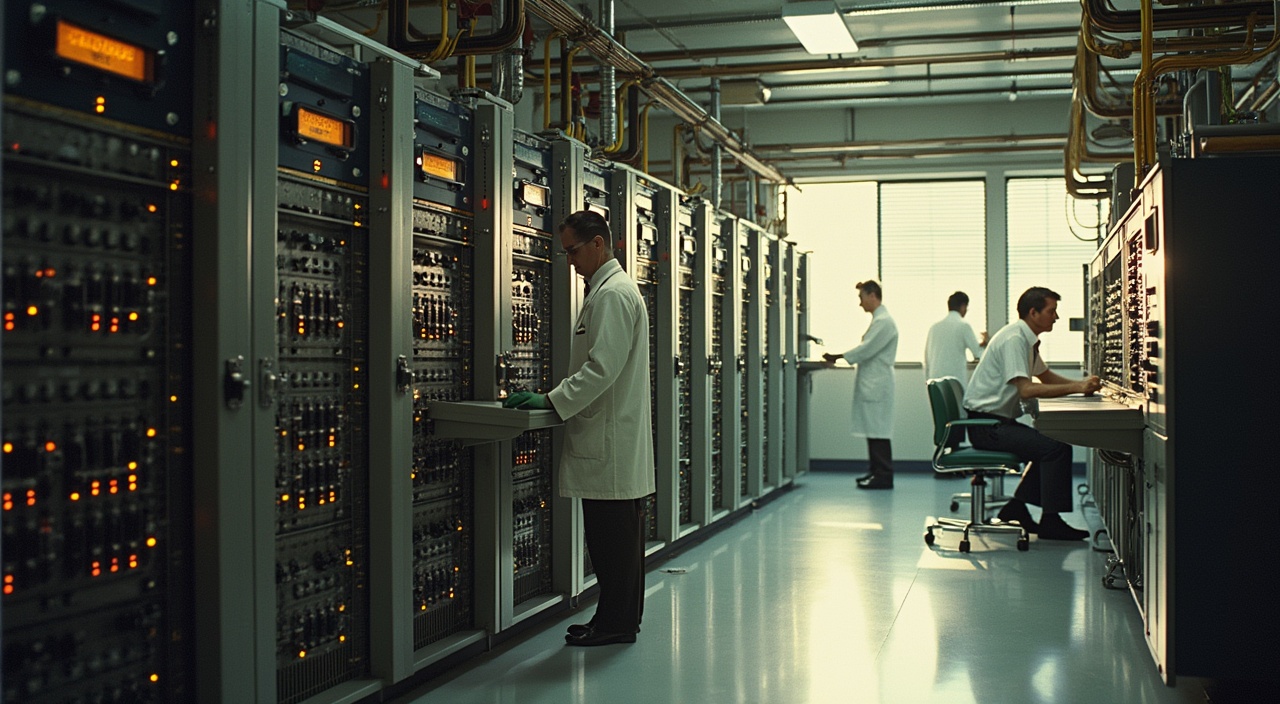this transformation goes beyond technological progress—it’s a story of democratization, where computational power has moved from exclusive institutional domains to personal empowerment.
Key Takeaways:
- Computational devices have shrunk from occupying entire rooms to fitting in your palm, with exponentially increased processing capabilities
- Personal computing revolutionized access, transferring technological power from institutions to individuals
- Mobile technology has achieved unprecedented global reach, connecting over 6 billion people
- Artificial intelligence is breaking traditional expertise barriers, enabling specialized knowledge access
- Human-AI collaboration represents the next frontier of technological innovation, amplifying rather than replacing human potential
I remember when I first encountered a mainframe computer early in my career. The contrast between those massive machines and today’s smartphones still amazes me. The processing power in your pocket now exceeds what filled entire buildings in the 1960s. Let that sink in.
The real revolution wasn’t just making computers smaller. It was making them personal. Before the 1980s, computing lived exclusively in government agencies, major corporations, and research institutions. Access required specialized training and organizational approval. The good news? The personal computer changed everything, putting computational power directly into individual hands.
Technology’s greatest achievement might be its reach
Mobile technology has connected over 6 billion people globally—a scale of human connection previously unimaginable. This connectivity creates opportunities for those who might otherwise remain isolated from economic and educational resources. I’ve seen this firsthand in my work with small businesses in developing markets. Their ability to participate in the global economy through simple mobile devices has created paths to prosperity previously blocked by geography.
But wait – there’s a catch: True digital empowerment requires more than access—it demands tools that amplify human capabilities without requiring everyone to become technical experts.
This is where I believe AI Agents Won’t Replace You—But They Might Change What It Means to Be You. The next phase of computing isn’t about making devices smaller or faster; it’s about making them smarter collaborators that understand our intentions and augment our abilities.
AI is breaking barriers to specialized knowledge
For small business owners, specialized expertise often sits behind prohibitive cost barriers. I’ve worked with countless entrepreneurs who couldn’t afford dedicated marketing teams or custom software development. Here’s the twist: AI is rapidly democratizing these capabilities.
You can now Transform Your Appointment-Based Business with AI: A Comprehensive Guide without hiring a team of developers. This accessibility changes the competitive landscape, allowing small businesses to deliver experiences previously exclusive to large corporations.
Picture this: A local therapist using AI to handle scheduling, follow-ups, and client communications—tasks that once required a full-time assistant. This doesn’t eliminate jobs; it elevates human work to focus on what matters most: client relationships and core services.
The democratization of computing isn’t just about technology—it’s about economic opportunity. When small businesses harness these tools effectively, they create stability and growth in their communities. That’s why I’ve focused on showing professionals how The Power of Blogging in Professional Services Marketing can establish authority and connect with ideal clients.
Ethical considerations must guide technological advancement
Access to powerful computing tools brings ethical responsibilities. I believe strongly in Walking the Fine Line: Marketing Your Expertise Ethically, especially as AI makes sophisticated marketing accessible to everyone.
The most important digital asset you control is your direct relationship with clients and customers. This explains why The one digital asset Mark Zuckerberg can’t touch (and why it matters more than ever) should be central to your business strategy.
Strange but true: Many business owners still build their entire presence on borrowed platforms while neglecting to develop owned channels like email lists and websites. This creates unnecessary vulnerability in an already challenging market.
Having guided numerous businesses through digital transformation, I’ve seen how the right approach creates sustainable advantage. My clients consistently report that strategic technology implementation delivers returns far beyond their investment. See What Joe Habscheid’s Clients Have to Say about Him.
The computing revolution continues to unfold. The next chapter will be defined not by how we adapt to technology, but by how effectively technology adapts to us. This human-centered approach represents the true promise of AI and computing—tools that understand human needs and seamlessly extend our capabilities.
When Giants Lived in Rooms: The Birth of Mainframe Computing
The 1950s to 1970s wasn’t just about poodle skirts and rock ‘n’ roll—it was also when IBM ruled computing with iron fists and room-sized machines. These weren’t your laptop’s ancestors; they were its great-great-grandparents who needed their own zip codes.
The Physical Behemoths
Early mainframes weren’t just big—they were massive. These electronic giants gobbled up 2,000–10,000 square feet of carefully climate-controlled space. That’s about half a basketball court at minimum! Each machine needed specialized rooms with raised floors for cooling and wiring.
The IBM 1401 became a runaway success, with over 12,000 units shipped. But don’t think these were impulse purchases—a 1401 would set you back $8,000 monthly in 1959 (that’s about $80,000 in today’s dollars).
Computing’s Exclusive Club
You couldn’t just pop down to Best Buy for a mainframe. The only organizations with deep enough pockets were:
- Government agencies needing to crunch census data
- Major universities conducting research
- Insurance companies managing mountains of customer information
- Banking institutions handling financial records
- Military operations requiring computational power
The System/360 family revolutionized computing by becoming an industry standard within just two years of its 1964 introduction. It made “batch processing” a household term—at least in households that could afford million-dollar computers.
Before personal computers democratized computing, these mainframes were the gatekeepers of computational power, creating a digital divide between organizations that could afford this technology and those that couldn’t.

The Personal Computer Revolution: Computing Democratized
The late 1970s marked the beginning of a seismic shift in computing history. Machines once occupying entire rooms became accessible to everyday people, kickstarting what I consider the most significant technology transformation of the 20th century.
From Institutional Giants to Desktop Companions
Before this revolution, computers existed primarily in government facilities, universities, and large corporations. The mainframe computers of the 1960s and early 70s cost millions and required specialized training to operate.
Then came the game-changers: the Apple II in 1977 and IBM PC in 1981. These weren’t just smaller computers—they represented a complete paradigm shift. They shipped over two million units within just a few years, bringing computing power directly to people’s homes and small businesses.
Why Personal Computing Changed Everything
The revolution succeeded for several key reasons:
- Affordability: Prices dropped from millions to thousands of dollars
- Accessibility: No special training required to operate
- Open architecture: Built with off-the-shelf components anyone could modify
- Software focus: Word processing, spreadsheets, and games made computers practical
This shift transferred power from institutions to individuals. For the first time, a person could buy a machine capable of running software they created themselves or purchased off a shelf. Computing wasn’t just democratized—it was personalized.
The impact extended beyond technology. Digital literacy became a possibility for millions, setting the foundation for our modern information economy and eventually paving the way for the AI revolution we’re experiencing today.

Computing Shrinks: The Mobile Technology Explosion
The computational power sitting in your pocket today dwarfs the capabilities of early mainframe computers that once filled entire rooms. This transformation happened faster than anyone predicted, creating a true mobile revolution that’s changed how we live, work, and connect.
The Scale of Mobile Dominance
Mobile devices have achieved what no other technology has accomplished in human history – reaching over 6 billion people globally in just a couple of decades. In many countries, the penetration rate exceeds 90%, making smartphones more common than indoor plumbing in some regions.
I’ve watched this shift happen right before my eyes. The first computer I programmed on took up half a classroom – now I carry something thousands of times more powerful in my back pocket. Talk about a shrinking act that would make any magician jealous!
Here’s what makes this mobile explosion so significant:
- Your smartphone contains more computing power than what sent humans to the moon
- Mobile connectivity enables instant communication across continents
- The average person checks their phone 96 times daily (that’s once every 10 minutes!)
- The computing-to-size ratio improves yearly, following Moore’s Law
- Mobile apps have created entirely new industries and career paths
This pocket computing revolution represents the fastest technological transformation humans have ever experienced. We’ve gone from massive UNIVAC machines to devices billions of times more powerful in a single lifetime. What’s next? The AI in your pocket might soon outthink the person carrying it.
Artificial Intelligence: Redefining Human Potential
I’ve watched AI evolve from science fiction to daily reality, transforming how we solve complex problems. The democratization of expertise through AI has created something unprecedented in human history – access to specialist-level knowledge without the traditional barriers of education or wealth.
Breaking Down Barriers to Expertise
AI’s impact spans multiple sectors, changing what’s possible for ordinary people:
- Healthcare: AI systems now diagnose certain conditions with accuracy rivaling specialists, bringing expert-level medical insights to underserved communities
- Education: Personalized learning systems adapt to individual student needs, providing tutoring previously available only to the privileged
- Mental health: AI companions offer 24/7 support for those who can’t access or afford traditional therapy
This shift isn’t without complications. Job markets face significant disruption as AI handles tasks once requiring human expertise. But I’ve seen how this technology creates new opportunities alongside challenges.
The technical foundation making this possible includes expert systems that capture human knowledge, deep learning that recognizes patterns humans might miss, and large language models that can process and generate human-like text.
What fascinates me most? The potential for truly universal access. When implemented thoughtfully, AI can deliver specialized services at marginal costs, making expertise available regardless of location or economic status. It’s not perfect – there are valid concerns about accuracy and bias – but the trajectory points toward something revolutionary: democratized expertise on a global scale.

Navigating the Human-AI Frontier
AI isn’t here to take my job—or yours. Instead, it’s offering us a chance to expand what we can accomplish. I’ve watched this technology develop from a curiosity into a powerful ally that’s helping tackle some of our biggest challenges.
Expanding Human Potential While Preserving Our Essence
AI has already started breaking down barriers in critical areas:
- Healthcare access: Remote communities can now receive diagnostic assistance where specialists aren’t available
- Educational equity: Personalized learning adapts to individual needs, helping students who might otherwise fall through the cracks
- Creative amplification: AI tools can handle repetitive tasks, freeing humans to focus on the creative aspects that no machine can replicate
The real magic happens at the intersection of human and artificial intelligence. A doctor’s empathy combined with AI’s pattern recognition. A teacher’s inspiration paired with adaptive learning algorithms. An artist’s vision enhanced by generative tools.
But this partnership requires thoughtful boundaries. I’ve always believed that technology should serve humanity, not the other way around. That means maintaining human agency in every AI system we develop.
The questions we face aren’t just technical but deeply human: Who controls these systems? Who benefits? How do we ensure they reflect our values and ethics?
The answers will shape not just our relationship with AI but our future as a species. As we continue this journey, let’s remember that the most powerful innovation happens when we use technology to amplify what makes us uniquely human.
The Continuing Human Story of Computing
The history of computers isn’t just about transistors and algorithms—it’s about us. Since the days of UNIVAC and early mainframe computers, each technological leap has extended human capabilities rather than replaced them.
Technology as Our Amplifier
I’ve watched computing transform from room-sized machines that only elite scientists could access to AI assistants in our pockets that help grandparents video chat with grandchildren. This evolution has consistently followed a pattern: what begins as scary becomes empowering.
Technology has always been our tool, not our replacement. Consider these human-centered developments:
- Early FORTRAN programming allowed scientists to solve previously impossible equations
- Personal computers democratized access to information and creative tools
- The internet connected human minds across vast distances
- Mobile computing freed us from physical constraints
- AI now amplifies our decision-making and creative capabilities
The narrative that technology diminishes humanity gets it backward. When IBM introduced early business computers, they didn’t eliminate jobs—they created entirely new industries.
I’ve helped businesses implement AI solutions, and I’ve seen firsthand that success comes when technology serves human priorities, not the reverse. As AI Agents Won’t Replace You—But They Might Change What It Means to Be You explains, technological advancement works best when it enhances our uniquely human qualities.
The most powerful aspect of our technological future isn’t the code itself—it’s our continued ability to decide what that code should do.

Sources:
• Wikipedia – Mainframe Computer
• Britannica – Computer: IBM Develops FORTRAN
• Wikipedia – UNIVAC
• TheStreet – History of IBM
• Britannica – Computer








